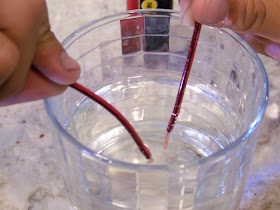I distinctly remember struggling in 6th grade science and my dad giving me a quizzical look during an intervention, maybe it was a parent-teacher conference, (I think I had a teetering B that was leaning toward a C and this was not cool). How could I not GET science? I have no idea. Perhaps I'm too right-brained. What I do know is what I'm able to glean and understand from science material comes from considerable studious effort. Science just makes my brain hurt.
A few years later, in high school, my chemistry teacher would come to our house to tutor me. I ended up doing okay in chemistry, but I never considered myself a science girlie. I guess the good thing is I never quit trying.
Well, I'm still trying. Thankfully there are awesome science texts out there that make science pretty palatable and even fun. I can't believe I just said I thought science was fun. I'm definitely learning!
Today the kids did a great little experiment. Although the book describes it as a learning exercise on atoms and molecules, I called it "Let's find out why Lady Liberty is green when she's made out of copper." Copper is, well...copper color right? That orangish, metallic color found in the inside of insulated electrical wire. Lady Liberty is made out of copper, but she is green. Why?
 |
| (Photo from Microsoft Office) |
Back to the experiment. Our kids love doing experiments, especially if they seem risky because there's going to be a molecular reaction. Grab the protective eyewear!
The supplies were a 9 volt battery, a small glass, baking soda, tape, protective eyewear and two 9-inch pieces of insulated copper wire.
 |
| Trimming the end of the plastic on the insulated wire exposing the copper wire. |
 |
| Taping the wires to the battery |
 |
| Patiently waiting while wearing protective eyewear. |
 |
| Double-checking to make sure the wires are connected. |
The kids then attached the copper wires to each end of the battery. One on the positive side, one on the negative. The glass was 3/4 full of water and 1 teaspoon of baking soda was thoroughly stirred in the water.
They then placed the two wires in the water. DO NOT LET THE WIRES TOUCH!!! I do not know what will happen if they do, but I'm a rule follower and the book instructed us to not let them touch. So we will not let them touch! You'll have to go to Mythbusters to have them find out what will happen if the wires touch.
Within a few minutes the ends of the wires started bubbling like crazy. The wire attached to the positive side of the battery quickly began turning a blueish green color. Oh, the excitement!!
 |
| Wires immersed, and NOT touching! |
 |
| The bubbles are starting. |
 |
| See the greenness? See the bubbles? |
 |
| Going Green! Still bubbling? |
 |
| Check out the results! |
So what did we learn?
In the glass were billions and billions of water molecules (h2o). Water molecules are compounds- hydrogen and oxygen. When we immersed the wires into the water while they were connected to the battery, electricity began flowing through the water. The bubbling we witnessed was actually water molecules being broken down from the energy in the electricity into hydrogen and oxygen atoms turning them into gases, hence the bubbling. This is worth repeating, the electricity broke apart the h2o molecules into separate hydrogen and oxygen atoms. Note: hydrogen is an explosive gas, oxygen we need to breathe. Combined they create water. Amazing!
Why did one wire turn a blueish-green color?
When we placed the copper wire in the baking soda water with the electricity many chemical reactions were occurring. Baking soda contains carbon atoms. We've already mentioned the breaking up of the water molecules creating the gas. The copper atoms linked with some of the oxygen atoms, carbon atoms and hydrogen atoms creating a new molecule called copper hydroxycarbonate. Copper hydroxycarbonate is the blueish-green substance we saw on the end of one of the wires.
So, now we've discovered why copper and or bronze (copper & tin) statues when exposed to weather undergo similar chemical reactions. The copper, and or bronze reacts with the hydrogen, oxygen and carbon atoms in the air combining to make copper hydroxycarbonate...the blueish-green color.
It's amazing! I learn something new everyday and I think I can safely say our kids do too!
Maybe I'll GET science after all. It's never too late.














We did this also. Dumb question, why did only one wire turn green when both ends bubbled?
ReplyDeleteThe negative ions in the solution were attracted to the positively charged copper wire and the electricity accelerated the reaction. The formation of the copper oxide turns the wire the blue green color. I hope this helps.
ReplyDeleteThis is so cool!!! I am turning it in as a science experiment on atoms.
ReplyDelete